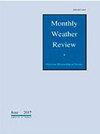Diagnosing Radial Ventilation in Dropsonde Observations of Hurricane Sam (2021)
IF 2.8
3区 地球科学
Q3 METEOROLOGY & ATMOSPHERIC SCIENCES
引用次数: 0
Abstract
This study presents a method to diagnose radial ventilation, the horizontal flux of relatively low-θe air into tropical cyclones, from dropsonde observations. We used this method to investigate ventilation changes over three consecutive sampling periods in Hurricane Sam (2021), which underwent substantial intensity changes over three days. During the first and last periods, coinciding with intensification, the ventilation was relatively small due to a lack of spatial correlation between radial flow and θe azimuthal asymmetries. During the second period, coinciding with weakening, the ventilation was relatively large. The increased ventilation was caused by greater shear associated with an upper-level trough, tilting the vortex, along with dry, low-θe air wrapping in upshear. The spatial correlation of the radial inflow and anomalously low-θe air resulted in large ventilation at mid-to-upper levels. Additionally, at low-to-mid levels, there was evidence of mesoscale inflow of low-θe air in the stationary band complex. The location of these radial ventilation pathways and their effects on Sam’s intensity are consistent with previous idealized and real-case modeling studies. More generally, this method offers a way to monitor ventilation changes in tropical cyclones, particularly when there is full-troposphere sampling around and within a tropical cyclone’s core.从飓风萨姆(2021 年)的垂吊观测数据中诊断径向通风情况
本研究提出了一种方法,可通过垂纬仪观测来诊断热带气旋的径向通气量,即相对低θe 空气的水平通量。我们使用这种方法研究了飓风萨姆(2021 年)在连续三个采样时段的通风变化,飓风萨姆在三天内强度发生了很大变化。在第一期和最后一期,由于径向流与θe方位角不对称之间缺乏空间相关性,通风量相对较小。在第二阶段,即减弱期,通气量相对较大。通风量增大的原因是与高空槽相关的切变增大,使涡旋倾斜,同时干燥的低θe空气被上切变包裹。径向流入气流和异常低θe空气的空间相关性导致中高层出现大量通风。此外,在中低层,有证据表明中尺度低θe空气流入静止带复合体。这些径向通风路径的位置及其对萨姆强度的影响与之前的理想化和真实案例建模研究相一致。更广泛地说,这种方法提供了一种监测热带气旋通风变化的方法,特别是在热带气旋核心周围和内部有全对流层取样的情况下。
本文章由计算机程序翻译,如有差异,请以英文原文为准。
求助全文
约1分钟内获得全文
求助全文
来源期刊

Monthly Weather Review
地学-气象与大气科学
CiteScore
6.40
自引率
12.50%
发文量
186
审稿时长
3-6 weeks
期刊介绍:
Monthly Weather Review (MWR) (ISSN: 0027-0644; eISSN: 1520-0493) publishes research relevant to the analysis and prediction of observed atmospheric circulations and physics, including technique development, data assimilation, model validation, and relevant case studies. This research includes numerical and data assimilation techniques that apply to the atmosphere and/or ocean environments. MWR also addresses phenomena having seasonal and subseasonal time scales.
文献相关原料
| 公司名称 | 产品信息 | 采购帮参考价格 |
|---|
 求助内容:
求助内容: 应助结果提醒方式:
应助结果提醒方式:


